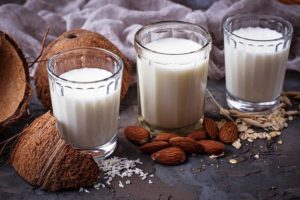
In our last blog post, we discussed the Perils of Dairy. So, it seemed obvious that the next thing we should address is the alternatives to dairy milk. In this post, we will look at soy, almond, rice, coconut and hemp milk. Here we go!
Soy Milk
Soy milk is the fluid drained from a mixture of ground soybeans and water. This is the closest to dairy milk of the chosen alternatives and contains about the same amount of protein, potassium, and calcium as dairy milk. And is often fortified with calcium, vitamins A, D and riboflavin and has 8 to 10 grams of protein per serving. But recently it has been getting bad press due to the use of GMOs (genetically modified organisms). Know this, if the soymilk you’re thinking about getting is labeled organic then it is free of GMOS. Read the nutrition label to see if it is fortified with the above vitamins and this will be a good alternative to dairy milk.
Now you should know that soy has had a bit of controversy surrounding it regarding breast cancer. Soy milk has isoflavones in it. Isoflavones are a weak-estrogen. In fact, our bodies estrogen is considered much stronger. Research about the effects of soy on cancer has been mixed. Most of the research has been done by observing population groups such as the Japanese. The average woman in East Asia eats about 10 times the quantity of soy as the average woman in the US. And eats more vegetables, is more physically active and is closer to their ideal body weight. And more than likely metabolizes their soy different from other women. All of these produce a healthier lifestyle and lower risk of breast cancer in Asian women living in Asia. There have been studies that suggest that these isoflavones can be a disrupter in the process of breast cell growth. If you have any hesitation using soy products, PLEASE consult your doctor. Please follow this link to see about other possible side effects.
Almond Milk
Since there has been a bit of confusion about possible side effects when consuming soy, almond milk has become popular. The only problem is that almond milk doesn’t come close to soy as far as having comparable nutrition content to dairy milk. Almond milk contains 1 gram of protein per cup. 1% dairy milk has 8 grams of protein per cup. But people seem to like the sweet flavor and creamy texture that is like dairy. Be aware that choosing sweeter versions adds from 2.5 to 5 teaspoons of sugar per cup. Almond milk does contain 50% of the daily value of vitamin E in one cup. And has 450 milligrams of calcium while 1% dairy has 305 milligrams of calcium. So, while the calcium, saturated fat and calories are better than dairy milk almond milk lacks the protein punch that dairy milk has. Your choice. (see interesting fact at the end of this article)
Rice Milk
Rice milk, made from ground brown rice and water, is highly recommended for those who have multiple food allergies. It’s low in nutrition so it would be best to use a brand that is supplemented with vitamin D and calcium.
Coconut Milk
There are two types of coconut milk. Canned coconut milk is the liquid expressed from coconut meat. It’s the nondairy equivalent to heavy cream with having 12 grams of fat per cup. “Coconut milk beverage” is watered down to lower the calories and fat. One cup has 45 calories and 4 grams of saturated fat. While not being nutritionally dense it is another good alternative for those who have multiple food allergies.
Hemp Milk
Hemp milk is made from filtered water and shelled hemp seeds (does not contain THC). It does contain calcium, vitamins D, A, E, B12 and 2 grams of protein. However, it does come in at 80 calories per cup which is higher than rice and almond milk. But is another suitable alternative if you have food allergies. Also, know that unless it is fortified it is low in calcium.
So, there it is. From the top down, in order your best alternatives to dairy milk.
A little interesting fact that I kept running into when doing the research on almonds. Know this, 99% of the almonds produced in the US are grown in California. California has been in a drought for quite some time. It takes 1.1 gallons of water to grow 1 almond. Yes, 1. I’ll stop there, but think about that for a minute next time you reach for a handful or even a dozen almonds. OUCH!